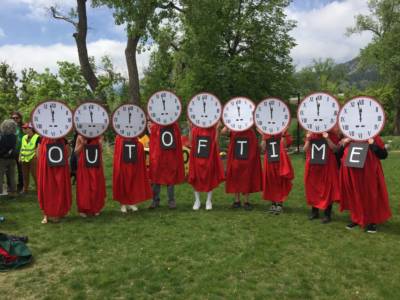Written by Intern Spencer Stepanek
Senate Bill 200, SB200, was every Coloradan climate warrior’s dream, granting our state the ability to hold large polluters accountable for their emissions. The bill itself didn’t pass, however much of its contents live on in another bill, House Bill 1266. Near the end of the legislative session, lots of initiative was required to pass even a portion of this climate justice legislature. Main portions of SB200 live on in a manner that retains key aspects of Governor Polis’ roadmap: monitoring and diminishing emissions in the electricity, oil/gas, and manufacturing sectors. 350 Colorado organized several movements to ensure this legislative content survived as a bill: this included a protest march past the Governor’s house! A new bill, House Bill 1266 (or HB1266) is the result of an endless stream of campaign initiatives using non-violent direct action (NVDA), designed to get climate warriors fighting for this bill in a safe and effective way.
This campaign’s crowd favorite climate warrior may well have been the clock-heads. These volunteers dawned clock-themed masks and outfits, then loomed around the Colorado Capitol Building (for almost two weeks straight!). The clock-heads wore signs reading “OUT OF TIME” to protest Governor Polis’ reluctance to pass the urgent climate initiative. The image of ten clocks looming near the base of the CO Capitol Building was frightening to behold, as if warning of an upcoming calamity. It proved a brilliant method for urging action. SB200/HB1266 is another stepping stone in the path to avert a climate catastrophe, but here’s how the clocks so effective in bolstering that legislature.
How We Changed the Bill
Lobbyists, passerbys, representatives, and the Governor himself all eventually saw the clock-heads in-person: a concerted direct action, on the steps of the capitol and outside the senate chambers. The impact was evident. People who favored the bill loved the clocks, and the bill’s antagonists hated them. Just about everyone in the building was talking about the people in clock suits, looming around the premises. In a space where lobbyists and legislature usually felt protected from outside accountability, it became clear that the people of Colorado were watching. Images of the clocks created lots of buzz on social media, most notably Senator Winter’s Twitter, where she gladly posed with the group for the photo (Senator Winter’s is one of the primary authors/sponsors of SB200).
Activists also marched to Governor Polis’ residence in Boulder. Characteristically stubborn, Polis’ stance on the veto for SB200 did not change. Though thanks to the barrage of pressure on passing SB200, he has not yet threatened to veto HB1266 (more about how that bill came to be further down). Razz Gormely, fellow clock-head and 350 Colorado advisory board member, commented: “This administration is very good at grabbing headlines, and creating a perception that they are progressive on climate and environmental justice issues… Actions like these allow us to recapture the narrative and wake the general public up to the fact that Polis is a wolf in sheep’s clothing”. A direct sense of publicity, along with a peaceful approach to outreach, allowed the clock-heads to inform many about the Governor’s threat to climate justice law and put Polis under pressure to let the next such bill pass, and most definitely changed the outcome of SB200 for the better.
What did this mean for SB200?
Near the end of this legislative session, it was crucial that the main content of SB200 find another home. That meant migrating its contents to a related bill, House Bill 1266. HB1266 originally aimed to support those disproportionately impacted by climate change, but has been extended to include SB200’s Environmental Justice themes.
What is HB1266?
HB1266 includes the regulations in SB200 that we’ve all been fighting for, and more. t’s a foundational legislature achievement: it creates a dedicated Environmental Justice Task Force, made from community members and other organizations to guide environmental policy and facility permitting; it more clearly defines the phrase “Disproportionately impacted community”; and requires even more pollution monitoring and prediction in those communities where pollution permits have been issued. Some worry that, in the process of combining these two bills, important things were lost. For example, HB1266 does not address transportation in any way. This is unfortunate, considering that the transportation sector is responsible for 25% of Colorado’s greenhouse gasses. The bill also fails to address buildings and infrastructure. There are other bills focusing on these issues, but it’s a shame they didn’t make an appearance in one of the largest climate justice legislative pieces this session.
Some are worried about the nature of this new bill: since it does not contain such rigid roadmarks for pollutant reduction, how will it hold? Some compromise is evident in the final product, where the possibility of a large polluter attempting to delay certain crucial landmarks is a legitimate concern. If not enforced, these landmark amounts of pollution will set Colorado on a track to destroy public health, as seen already in such disproportionately impacted communities. Our action to stop and reverse dangerous polluting is most crucial now, where communities like Commerce City are sustaining measurable health impacts thanks to water pollution: this is the premise that gets people on their feet to fight for climate justice! These definite impacts should remind everyone that the clock is ticking, and that we have a right and an obligation to make our demands known to lobbyists and lawmakers in our state.
350 Colorado’s non-violence direct action, by means of clock suits, swarms of climate justice advocates, and more, is our means of being heard. The content passed on from SB200 into HB1266 was only bolstered by 350 Colorado’s many campaign movements in the Denver area. Clock-suit-people (and normal people, alike) particularly succeeded at putting the fight for climate justice in a different lens. Their demeanor was stoic and passive throughout the campaign, which did well to portray the current state of pollution’s effects on Colorado and its communities.

